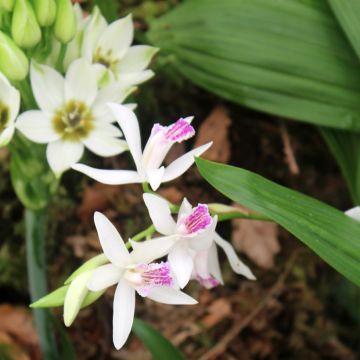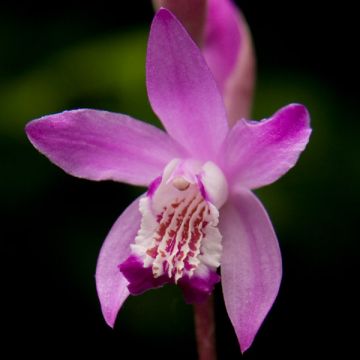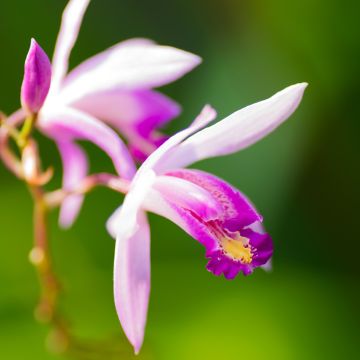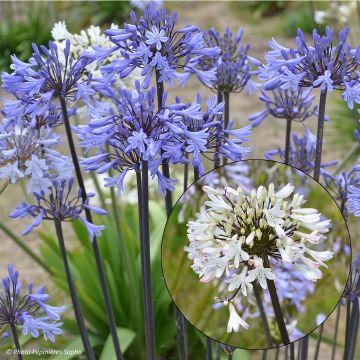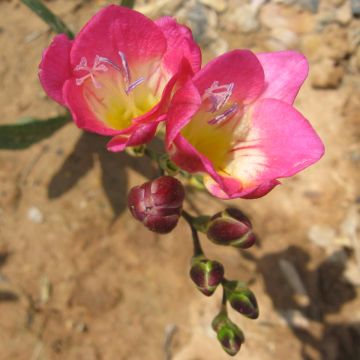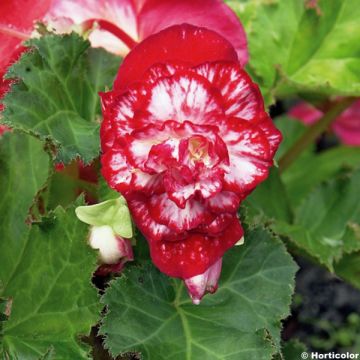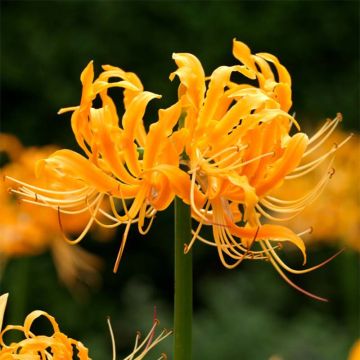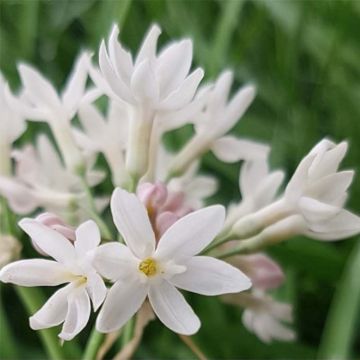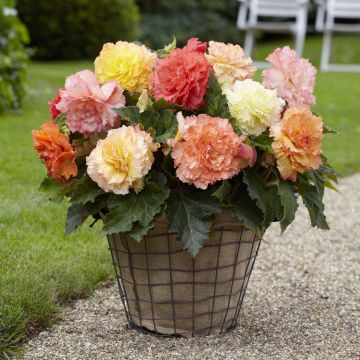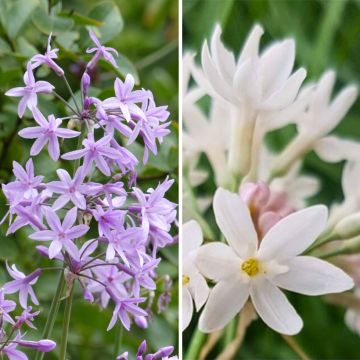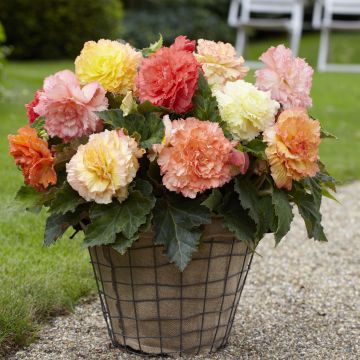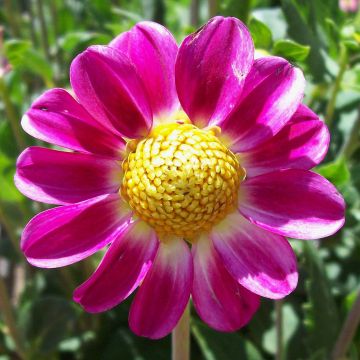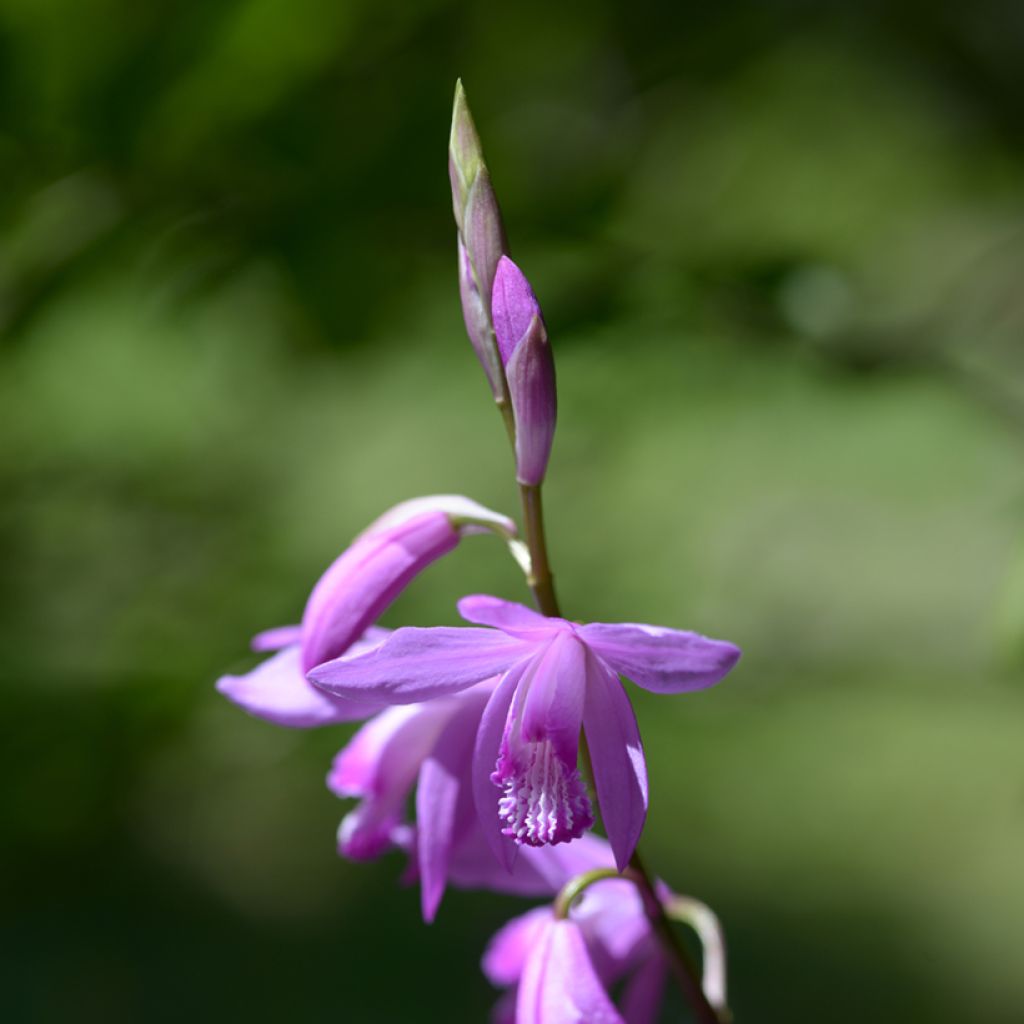

Bletilla striata - Hyacinth Orchid
Bletilla striata - Hyacinth Orchid
Bletilla striata
Hyacinth Orchid, Chinese Ground Orchid
This item cannot be shipped to the selected country
Delivery charge from €5.90
More information
Schedule delivery date,
and select date in basket
This plant carries a 12 months recovery warranty
More information
We guarantee the quality of our plants for a full growing cycle, and will replace at our expense any plant that fails to recover under normal climatic and planting conditions.
From €5.90 for pickup delivery and €6.90 for home delivery
Express home delivery from €8.90.
Does this plant fit my garden?
Set up your Plantfit profile →
Description
The Bletilla striata, known as the hyacinth orchid, is a fairly hardy terrestrial orchid that adapts well to most climates. Charming, it blooms for a month in early summer, offering loose spikes of small flowers with pink to violet petals and a white labellum marked with purple. The flowers emerge from a clump of large light green leaves, reminiscent of gladiolus leaves. The Bletilla striata spreads slowly and can easily cover places it likes, whether in partial shade or under morning sun, in a cool, humus-bearing, well-drained soil.
The hyacinth orchid, also known as Bletilla hyacinthina, is a herbaceous geophyte plant with flattened pseudo-bulbs belonging to the orchid family. It is native to Japan, China, and Tibet. The plant produces young shoots from April onwards, which unfold into a cluster of long oblong to lanceolate, pleated leaves, about thirty centimetres long. In June-July, violet-tinged flower stalks appear, bearing 6 to 10 flowers with a diameter of 3 cm. Each flower consists of 4 pink to violet petals surrounding a tubular pink labellum, the white throat of which is striated with the same shade of pink. After blooming for about a month, the flowers disappear, while the foliage persists until November. The plant then goes dormant until spring. Bletilla striata easily multiplies by forming pseudo-bulbs, eventually forming beautiful clumps. Unlike the majority of other species, this orchid does not seem to live in symbiosis with a specific fungus, which makes it easy to establish in the garden.
Report an error about the product description
Flowering
Foliage
Plant habit
Botanical data
Bletilla
striata
Orchidaceae
Hyacinth Orchid, Chinese Ground Orchid
China
Other Bletillas or Hyacinth Orchids
Planting and care
Bletillas are the hardiest orchids. They can withstand frost in well-drained, neutral or slightly acidic soil. Plant Bletilla striata in light compost, 5 to 7 cm deep, spaced 15 to 20 cm apart, in a sunny location sheltered from the burning sun. In the northern region, we grow them in pots and keep them frost-free during winter.
Pot cultivation: Place 3 to 5 bulbs per pot with a diameter of 20 cm, in a mixture of 1/3 potting soil, 1/3 sand, and 1/3 garden soil. After flowering, remove the foliage and place the pots in a frost-free location until spring.
In warmer regions, this orchid can be left in the ground during winter, covered with protective mulch. Watering should be regular and consistent during dry summers.
Planting period
Intended location
Care
This item has not been reviewed yet - be the first to leave a review about it.
Bulbs to grow in pots
Haven't found what you were looking for?
Hardiness is the lowest winter temperature a plant can endure without suffering serious damage or even dying. However, hardiness is affected by location (a sheltered area, such as a patio), protection (winter cover) and soil type (hardiness is improved by well-drained soil).

Photo Sharing Terms & Conditions
In order to encourage gardeners to interact and share their experiences, Promesse de fleurs offers various media enabling content to be uploaded onto its Site - in particular via the ‘Photo sharing’ module.
The User agrees to refrain from:
- Posting any content that is illegal, prejudicial, insulting, racist, inciteful to hatred, revisionist, contrary to public decency, that infringes on privacy or on the privacy rights of third parties, in particular the publicity rights of persons and goods, intellectual property rights, or the right to privacy.
- Submitting content on behalf of a third party;
- Impersonate the identity of a third party and/or publish any personal information about a third party;
In general, the User undertakes to refrain from any unethical behaviour.
All Content (in particular text, comments, files, images, photos, videos, creative works, etc.), which may be subject to property or intellectual property rights, image or other private rights, shall remain the property of the User, subject to the limited rights granted by the terms of the licence granted by Promesse de fleurs as stated below. Users are at liberty to publish or not to publish such Content on the Site, notably via the ‘Photo Sharing’ facility, and accept that this Content shall be made public and freely accessible, notably on the Internet.
Users further acknowledge, undertake to have ,and guarantee that they hold all necessary rights and permissions to publish such material on the Site, in particular with regard to the legislation in force pertaining to any privacy, property, intellectual property, image, or contractual rights, or rights of any other nature. By publishing such Content on the Site, Users acknowledge accepting full liability as publishers of the Content within the meaning of the law, and grant Promesse de fleurs, free of charge, an inclusive, worldwide licence for the said Content for the entire duration of its publication, including all reproduction, representation, up/downloading, displaying, performing, transmission, and storage rights.
Users also grant permission for their name to be linked to the Content and accept that this link may not always be made available.
By engaging in posting material, Users consent to their Content becoming automatically accessible on the Internet, in particular on other sites and/or blogs and/or web pages of the Promesse de fleurs site, including in particular social pages and the Promesse de fleurs catalogue.
Users may secure the removal of entrusted content free of charge by issuing a simple request via our contact form.
The flowering period indicated on our website applies to countries and regions located in USDA zone 8 (France, the United Kingdom, Ireland, the Netherlands, etc.)
It will vary according to where you live:
- In zones 9 to 10 (Italy, Spain, Greece, etc.), flowering will occur about 2 to 4 weeks earlier.
- In zones 6 to 7 (Germany, Poland, Slovenia, and lower mountainous regions), flowering will be delayed by 2 to 3 weeks.
- In zone 5 (Central Europe, Scandinavia), blooming will be delayed by 3 to 5 weeks.
In temperate climates, pruning of spring-flowering shrubs (forsythia, spireas, etc.) should be done just after flowering.
Pruning of summer-flowering shrubs (Indian Lilac, Perovskia, etc.) can be done in winter or spring.
In cold regions as well as with frost-sensitive plants, avoid pruning too early when severe frosts may still occur.
The planting period indicated on our website applies to countries and regions located in USDA zone 8 (France, United Kingdom, Ireland, Netherlands).
It will vary according to where you live:
- In Mediterranean zones (Marseille, Madrid, Milan, etc.), autumn and winter are the best planting periods.
- In continental zones (Strasbourg, Munich, Vienna, etc.), delay planting by 2 to 3 weeks in spring and bring it forward by 2 to 4 weeks in autumn.
- In mountainous regions (the Alps, Pyrenees, Carpathians, etc.), it is best to plant in late spring (May-June) or late summer (August-September).
The harvesting period indicated on our website applies to countries and regions in USDA zone 8 (France, England, Ireland, the Netherlands).
In colder areas (Scandinavia, Poland, Austria...) fruit and vegetable harvests are likely to be delayed by 3-4 weeks.
In warmer areas (Italy, Spain, Greece, etc.), harvesting will probably take place earlier, depending on weather conditions.
The sowing periods indicated on our website apply to countries and regions within USDA Zone 8 (France, UK, Ireland, Netherlands).
In colder areas (Scandinavia, Poland, Austria...), delay any outdoor sowing by 3-4 weeks, or sow under glass.
In warmer climes (Italy, Spain, Greece, etc.), bring outdoor sowing forward by a few weeks.


































